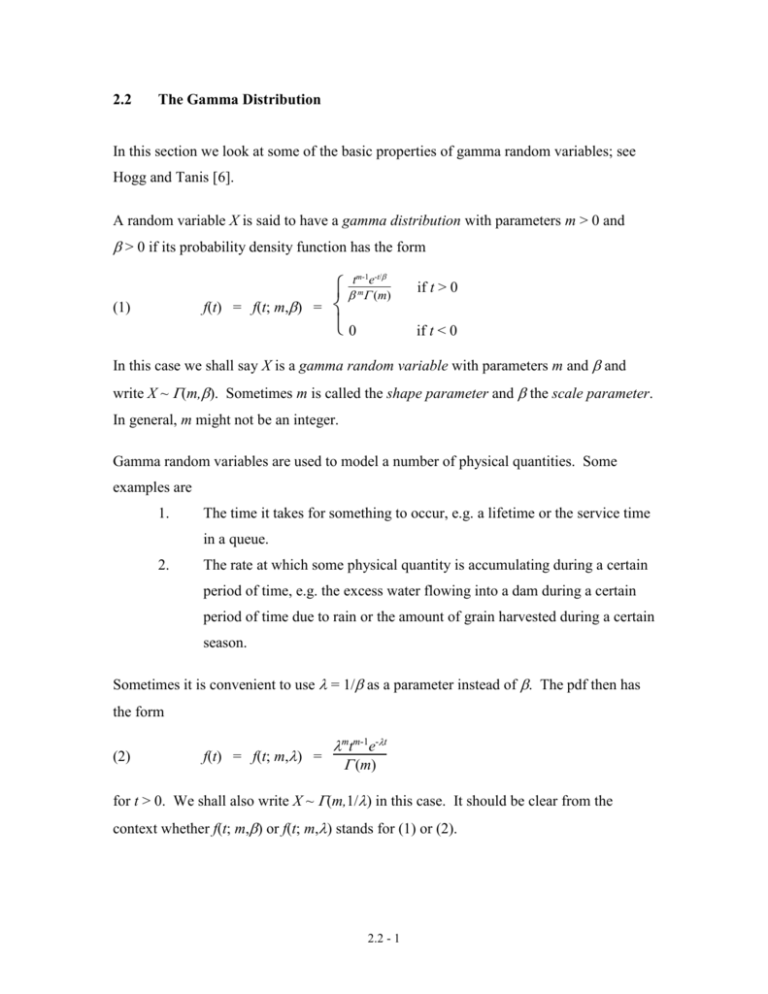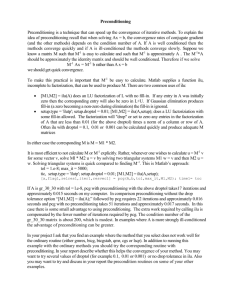Sums of Gamma Random Variables
advertisement

2.2
The Gamma Distribution
In this section we look at some of the basic properties of gamma random variables; see
Hogg and Tanis [6].
A random variable X is said to have a gamma distribution with parameters m > 0 and
> 0 if its probability density function has the form
f(t) = f(t; m,) =
(1)
tm-1e-t/
m
(m)
0
if t > 0
if t < 0
In this case we shall say X is a gamma random variable with parameters m and and
write X ~ (m,). Sometimes m is called the shape parameter and the scale parameter.
In general, m might not be an integer.
Gamma random variables are used to model a number of physical quantities. Some
examples are
1.
The time it takes for something to occur, e.g. a lifetime or the service time
in a queue.
2.
The rate at which some physical quantity is accumulating during a certain
period of time, e.g. the excess water flowing into a dam during a certain
period of time due to rain or the amount of grain harvested during a certain
season.
Sometimes it is convenient to use = 1/ as a parameter instead of . The pdf then has
the form
(2)
f(t) = f(t; m,) =
mtm-1e-t
(m)
for t > 0. We shall also write X ~ (m,1/) in this case. It should be clear from the
context whether f(t; m,) or f(t; m,) stands for (1) or (2).
2.2 - 1
Proposition 1. If m > 0 and > 0 then
m-1 -t/
t m e dt
(m)
(3)
= 1
0
which confirms that f(t) defined by (1) is a valid density function.
0
0
m-1 -t/
um-1e-u
t e
m-1 -u
Proof. m
dt =
du
=
1
since
(m)
=
(m)
u e du.
(m)
0
Proposition 2. If X has a gamma distribution with parameters m and , then the mean of
X is
m-1 -t/
t e
X = E(X) = t m (m) dt = m
(4)
0
Proof. t
m -t/
m-1 -t/
t e
t m e dt =
m (m) dt
(m)
0
0
tme-t/
= m m+1
dt = m
f(t;m+1,) dt = m
(m+1)
0
0
where we have used (m+1) = m (m) and (3).
Proposition 3. If X has a gamma distribution with parameters m and , then the
expected value of X2 is
(5)
m-1 -t/
t e
E(X ) = t2 m (m) dt
2
= m(m+1)2
0
The variance of X is
(6)
(X)2 = E((X - X)2) = m2
The standard deviation of X is
2.2 - 2
X =
(7)
m
tm+1e-t/
t e
2 t e
2
Proof.
t
dt = m
dt = m(m+1) m+2
dt =
m (m)
(m)
(m+2)
m-1 -t/
0
m+1 -t/
0
0
2
m(m+1)
f(t;m+2,) dt = m(m+1) where we have used (m+2) = m(m+1) (m) and
2
0
(3). This proves (5). Since E((X - X)2) = E(X2) - X2 the formula (6) follows from (4)
and (5). (7) follows from (6).
Proposition 4. If f(t) is given by (1) then for t > 0 one has
[(m - 1) - t] tm-2e-t/
m+1 (m)
(8)
f '(t) =
(9)
f(t) has a single local maximum at t = (m - 1) if m > 1.
(10)
f(t) is strictly decreasing for t > 0 if m 1
Proof. (8) is a straightforward computation and (9) and (10) follow from (8).
Proposition 5. Assume X has a gamma distribution with parameters m and and let
Y = cX for some positive number c. Then Y has a gamma distribution with parameters m
and c.
Proof. If f(t) given by (1) is the density function of X then the density function of Y is
tm-1e-t/(c)
(c) (m)
0
m
(1/c)f(t/c)
=
if t > 0
if t < 0
which is equal to f(t; m,c).
2.2 - 3
Proposition 5. If X and Y are independent gamma random variables and X has
parameters m and and Y has parameters q and , then X + Y is a gamma random
variable with parameters m + q and .
Proof. We first show that
1
(12)
um-1(1-u)q-1 du = B(m, q)
0
where
(12)
B(m, q) =
/2
(m) (q)
2m-1
2q-1
= 2
cos (t) sin (t) dt
(m +q )
0
0
0
m-1 q-1 -(t+s)
is the beta function. To see this first note that (m) (q) =
dsdt. Make
t s e
the change of variables r = t + s and u = t/(t+s). Then t = ru and s = r(1-u) and dsdt =
rdudr and the first quadrant in the st-plane gets mapped into the strip {(r,u): 0 < r < , 0
1
(ru)
< u < 1}. So (m) (q) =
m-1
0
1
um-1(1-u)q-1 du
(r(1-u)) e rdudr = (m +q )
q-1 -r
0
0
and (12) follows. Next we show that
(13)
m-1
q-1
t
t
*
(m) (q)
=
tm+q-1
(m +q)
t
To see this note that t
m-1
*t
q-1
sm-1(t-s)q-1 ds. Make the change of variables s = tu.
=
0
1
1
m-1
q-1
m+q-1
m-1
q-1
m+q-1 (m) (q)
We get tm-1 * tq-1 =
(tu)
(t-tu)
tdu
=
t
u (1-u) du = t
(m +q )
0
0
and (13) follows. It follows from (11) and (13) that
tm+q-1e-t/
tm-1e-t/ tq-1e-t/
f(t; m,) * f(t; q,) = m
= f(t; m+q,)
* q
= m+q
(m +q)
(m) (q)
and the propostion follows.
2.2 - 4
Proposition 6. If X has a gamma distribution with parameters m and = 1/, then the
Laplace transform L(s) and moment generating function M(r) of X are given by
(14)
L(s) =
(15)
M(r) =
1
=
(1 + s)m
( + s)m
1
(1 - r)
m
=
( - s)m
Proof. One has
0
0
-st -m m-1 -t/
-1
-m m-1 -(s+1/)t
L(s) = [ (m)]-1
dt
e t e dt = [ (m)]
t e
If one makes the change of variables u = (s + 1/)t one obtains
-m(u/(s + 1/))m-1e-u (1/(s + 1/))du
L(s) = [ (m)]
-1
0
1
um-1e-u du =
= (1/(1 + s)) [ (m)]
(1 + s)m
m
-1
0
This proves (14). (15) follows from the (14) and the fact that M(r) = L(-r).
Let
t
t
(16)
m-1 -s/
s e
f(s;m,) ds = m
G(t) = G(t;m,) =
ds
(m)
0
0
be the cummulative distribution function of the gamma random variable X ~ (m,) and
let
(17)
m-1 -s/
s e
H(t) = H(t;m,) = 1 - G(t) = m (m) ds
t
be the complementary distribution function (or survival function). Let
(18)
m-1 -s
m(t) =
s e ds
t
be the upper incomplete gamma function and
t
(19)
m-1 -s
m(t) =
s e ds
0
be the lower incomplete gamma function.
2.2 - 5
Proposition 7.
(t/)
(20)
G(t;m,) = m (m)
(21)
H(t;m,) =
m(t/)
(m)
Proof. (20) follows by making the change of variables u = s/ in (16) and (21) follows
by making the change of variables u = s/ in (17).
2.2 - 6









